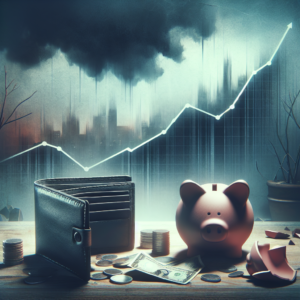
In recent years, the United States has witnessed a troubling increase in personal bankruptcy filings, raising concerns among economists, policymakers, and individuals alike. The phenomenon, once thought to be a consequence of economic downturns, has now taken on a life of its own, prompting a closer examination of the underlying causes and implications. This article delves into the current landscape of personal bankruptcy, exploring the factors contributing to its rise, the demographic shifts affecting those most impacted, and the legal and financial ramifications of filing for bankruptcy. Furthermore, we will discuss strategies individuals can adopt to avoid falling into the cycle of bankruptcy in the future.
Understanding the Current Landscape of Personal Bankruptcy in the United States
The landscape of personal bankruptcy in the United States has evolved significantly over the past decade. According to the American Bankruptcy Institute, personal bankruptcy filings reached a staggering 800,000 in 2022, marking a 30% increase from the previous year. This surge has been attributed to a combination of factors, including the lingering effects of the COVID-19 pandemic, inflationary pressures, and rising interest rates. The two primary types of personal bankruptcy—Chapter 7 and Chapter 13—have seen varied trends, with Chapter 7 filings dominating the landscape due to its quicker resolution process. As individuals grapple with mounting debts, the implications of these filings extend beyond personal finances, affecting credit scores, housing stability, and overall economic health.
Key Factors Contributing to the Surge in Bankruptcy Filings Among Individuals
Several key factors have contributed to the alarming rise in personal bankruptcy filings. First and foremost, the economic fallout from the COVID-19 pandemic has left many individuals and families struggling to regain financial stability. Job losses, reduced hours, and business closures have created a perfect storm of financial distress. Additionally, rising costs of living, particularly in housing, healthcare, and education, have placed an unprecedented strain on household budgets. The increasing prevalence of medical debt, which remains a leading cause of bankruptcy, further exacerbates the situation. Moreover, the recent surge in interest rates has made it more challenging for individuals to manage existing debts, leading many to consider bankruptcy as a viable option for relief.
The Impact of Economic Trends on Personal Financial Stability and Bankruptcy Rates
Economic trends play a pivotal role in shaping personal financial stability and influencing bankruptcy rates. The current inflationary environment has eroded purchasing power, forcing consumers to allocate a larger portion of their income to essential expenses. This shift has left little room for savings or debt repayment, pushing many individuals to the brink of financial collapse. Additionally, the Federal Reserve’s decision to raise interest rates in an effort to combat inflation has resulted in higher borrowing costs, making it increasingly difficult for individuals to manage credit card debt and other loans. As a result, the combination of stagnant wages, rising costs, and increased borrowing expenses has created a precarious financial landscape, prompting many to seek bankruptcy protection as a last resort.
Analyzing Demographic Shifts: Who is Most Affected by Personal Bankruptcy?
Demographic shifts reveal that certain groups are disproportionately affected by personal bankruptcy. Recent studies indicate that younger adults, particularly those aged 25 to 34, are filing for bankruptcy at higher rates than previous generations. This trend can be attributed to factors such as student loan debt, stagnant wages, and the challenges of entering the housing market. Additionally, single-parent households, particularly those led by women, are experiencing significant financial strain, leading to increased bankruptcy filings. Racial and ethnic minorities also face higher rates of bankruptcy, often due to systemic economic disparities and limited access to financial resources. Understanding these demographic trends is crucial for developing targeted interventions to address the underlying issues contributing to personal bankruptcy.
Legal Implications and Consequences of Filing for Personal Bankruptcy
Filing for personal bankruptcy carries significant legal implications and consequences that individuals must carefully consider. While bankruptcy can provide a fresh start by discharging certain debts, it also has lasting effects on an individual’s credit report, remaining for up to ten years. This can hinder future borrowing opportunities, making it difficult to secure loans for major purchases such as homes or cars. Additionally, individuals may face challenges in obtaining employment, as some employers conduct credit checks as part of the hiring process. Furthermore, the bankruptcy process itself can be complex and time-consuming, often requiring the assistance of legal professionals to navigate the intricacies of the law. Understanding these implications is essential for individuals contemplating bankruptcy as a solution to their financial woes.
Strategies for Prevention: How Individuals Can Avoid Bankruptcy in the Future
To mitigate the risk of bankruptcy, individuals can adopt several proactive strategies aimed at enhancing financial resilience. First and foremost, creating and adhering to a comprehensive budget can help individuals track their income and expenses, allowing for better financial planning. Building an emergency fund, even a modest one, can provide a financial cushion in times of unexpected expenses or job loss. Additionally, seeking financial education and counseling can empower individuals with the knowledge and skills necessary to manage debt effectively. Prioritizing debt repayment, particularly high-interest debts, can also alleviate financial pressure. Finally, cultivating healthy financial habits, such as regular savings and prudent spending, can significantly reduce the likelihood of falling into the cycle of bankruptcy.
The rise in personal bankruptcy filings in the United States serves as a stark reminder of the challenges many individuals face in today’s economic climate. By understanding the factors contributing to this trend, the demographic shifts at play, and the legal implications of bankruptcy, individuals can better navigate their financial landscapes. Moreover, implementing effective prevention strategies can empower individuals to take control of their financial futures, ultimately reducing the incidence of personal bankruptcy. As the nation grapples with these pressing issues, a collective effort is needed to address the root causes of financial instability and foster a more resilient economy for all.




















